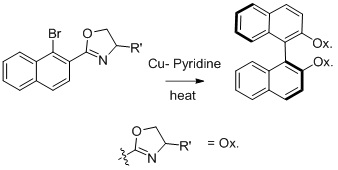Ullmann reaction
| Ullmann reaction | |
|---|---|
| Named after | Fritz Ullmann |
| Reaction type | Coupling reaction |
| Identifiers | |
| Organic Chemistry Portal | ullmann-reaction |
| RSC ontology ID | RXNO:0000040 |
The Ullmann reaction or Ullmann coupling, named after Fritz Ullmann, couples two aryl or alkyl groups with the help of copper. The reaction was first reported by Ullmann and his student Bielecki in 1901. It has been later shown that palladium and nickel can also be effectively used.[1][2]

Aryl-Aryl bond formation is a fundamental tool in modern organic synthesis, with applications spanning natural product synthesis, pharmaceuticals, agrochemicals, and the development of commercial dyes and polyaromatics. With over a century of history, the Ullmann reaction has been one of the first to use a transition metal, primarily copper, in its higher oxidation states. Despite the significant implications of biaryl coupling in industries, the Ullmann reaction was plagued by a number of problems in its early development. However, in modern times the Ullmann reaction has revived interest due to several advantages of copper over other catalytic metals.
Mechanism
The
Scope
Fritz Ullmann and his student Bielecki were the first to report the reaction.[8] This groundbreaking result was the first to show that a transition metal could help perform an aryl carbon-carbon bond formation.
A typical example of classic Ullmann biaryl coupling is the conversion of ortho-chloronitrobenzene into 2,2'-dinitrobiphenyl with a copper - bronze alloy.[9][10]
- 2 C6H4(NO2)Cl + 2 Cu → (C6H4(NO2))2 + 2 CuCl
The reaction has been applied to fairly elaborate substrates.
The traditional version of the Ullmann reaction requires stoichimoetric equivalents of copper, harsh reaction conditions, and the reaction has a reputation for erratic yields. The traditional Ullmann reaction thus had poor atom economy and produced toxic CuI. Because of these problems many improvements and alternative procedures have been introduced.[11][12][13]
The classical Ullmann reaction is limited to electron deficient aryl halides (hence the example of 2-nitrophenyl chloride above) and requires harsh reaction conditions. Modern variants of the Ullman reaction employing palladium and nickel have widened the substrate scope of the reaction and rendered reaction conditions more mild. Yields are generally still moderate, however.
Biphenylenes had been obtained before with reasonable yields using 2,2-diiodobiphenyl or 2,2-diiodobiphenylonium ion as starting material.
Closure of 5-membered rings is more facile, but larger rings have also been made using this approach.

- Modern developments also include the use of heterogeneous copper catalysts and nanoparticles. These are highly desirable as the catalyst can be easily separated from the products, reducing waste and cost. [15] In the case of copper nanoparticles, the catalytic activity depended on its size and the formation of aggregates.
Bidentate ligands for Ullmann Coupling
Around the year 2000, various bidentate ligands were found to improve the efficieny of the Ullmann reaction. Bidentate ligands allow for milder reaction conditions and higher functional group tolerance. They included amino acids, oxines, Schiff bases, and many other O-O or N-N bidentates.[16][17][18] These initial bidentate systems elevated the practicality of Ullmann reactions but it still had drawbacks. High loadings of copper and ligand were required and activation of the notoriously difficult aryl-chloride was still not possible. These problems were solved in 2015 with the design of special oxalic diamine ligands, making the Ullmann reaction viable for industrial application.[19]
Unsymmetric and asymmetric couplings
Ullmann synthesis of biaryl compounds can be used to generate chiral products from chiral reactants.[20] Nelson and collaborators worked on the synthesis of asymmetric biaryl compounds and obtained the thermodynamically controlled product.[20]
The diastereomeric ratio of the products is enhanced with bulkier R groups in the auxiliary oxazoline group.
Unsymmetrical Ullmann reactions are rarely pursued but have been achieved when one of the two coupling components is in excess.[12]
Imidazole Ullmann reaction
The Ullmann reaction is limited to electron-deficient aryl halides and requires harsh reaction conditions. In organic synthesis this reaction is often replaced by palladium coupling reactions such as the Heck reaction, the Hiyama coupling, and the Sonogashira coupling
In a variation of the Ullmann reaction, β-bromostyrene is reacted with imidazole in an ionic liquid such as 1-butyl-3-methylimidazolium tetrafluoroborate to give an N-styrylimidazole.[21] The reaction requires Lproline in addition to copper iodide as catalyst.

Industrial Applications
Aqueous Ullmann reactions have been used on the pilot plant scale.[22]
See also
- Ullmann condensation - copper-promoted conversion of aryl halides to ethers, also developed by Fritz Ullmann
- Copper(I) thiophene-2-carboxylate, a copper reagent used in the Ullmann reaction
- Wurtz–Fittig reaction, a similar reaction useful for alkylbenzenes synthesis
References
- ISSN 0009-2665.
- ISSN 0931-7597.
- PMID 18597458.
- University of Massachusetts at Amherst 2004. Electronic thesis
- ISSN 0368-1769.
- ISSN 0022-3263.
- ISSN 1460-4744.
- ISSN 0365-9496.
- .
- S2CID 30018391.
- .
- ^ PMID 11996540.
- PMID 24585151.
- ISBN 0-471-26418-0.
- ISSN 1460-4744.
- ISSN 0931-7597.
- ISSN 0947-6539.
- ISSN 0002-7863.
- . Retrieved 2023-12-08.
- ^ .
- doi:10.1039/b501628b
- S2CID 55030715.






